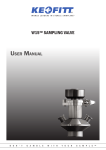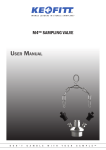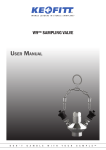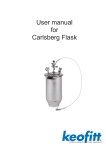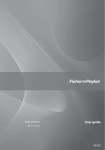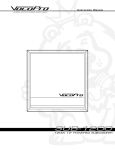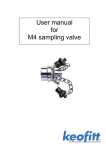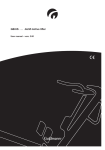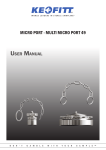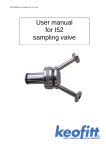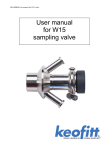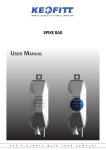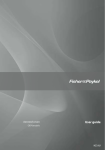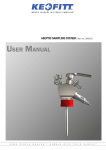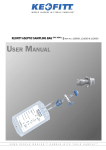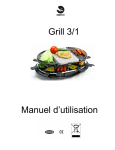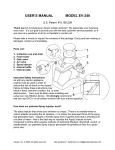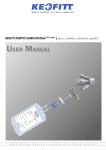Download User Manual
Transcript
W25™ SAMPLING VALVE User Manual D O N ’ T G A M B L E W I T H Y O U R S A M P L E ™ DOCUMENT VERSION LOG The table below lists previous versions of this User Manual and states the major changes between versions. This version list is introduced in October 2015. Version # Version date 1 8th October 2015 Major changes from previous versions Complete revision and new layout. INTRODUCTION: MANUFACTURER: Keofitt A/S Kullinggade 31 5700 Svendborg, Denmark TYPE: W25™ SAMPLING VALVE PATENTS: U.S. PAT. 5,246,204 • E.P. 0468957 YEAR OF INTRODUCTION:2002 YEAR OF REVISED DESIGN: 2014 LAST UPDATED: Oct 2015 The English version of this Manual is the governing version and it is the only authorized version. Consequently, KEOFITT cannot be held liable for other versions including translations of this Manual. CONTENTS 1. PRESENTATION.............................................................................................................................. 7 1.1 Definition of terms.............................................................................................................................7 1.2 Quick start.........................................................................................................................................9 2. CLEANING – DISINFECTION – STERILISATION ..........................................................................10 2.1 Clean-In-Place (CIP)........................................................................................................................ 10 2.2 Disinfection.................................................................................................................................... 10 2.3 Sterilisation.................................................................................................................................... 11 3. VALVE FUNCTION.........................................................................................................................12 4. EVERYDAY USE OF THE VALVE....................................................................................................14 4.1 Pre-production treatment.............................................................................................................. 14 4.2 Chemical cleaning, CIP.................................................................................................................. 14 4.3 Chemical Disinfection.................................................................................................................... 14 4.4 Steam sterilisation......................................................................................................................... 14 5. VALVE OPERATIONS....................................................................................................................15 5.1 Chemical CIP.................................................................................................................................. 15 5.2 Chemical disinfection.................................................................................................................... 16 5.3 Steam sterilisation......................................................................................................................... 18 5.4 Sampling......................................................................................................................................... 20 6. TECHNICAL DATA..........................................................................................................................21 6.1 Material............................................................................................................................................ 21 6.2 Certificate........................................................................................................................................ 21 6.3 Pressure (max.)............................................................................................................................... 21 6.4 Temperature (max.)......................................................................................................................... 21 6.5 Surface treatment........................................................................................................................... 21 7. VALVE BODIES..............................................................................................................................22 8. VALVE HEADS...............................................................................................................................23 9. PARTS & ACCESSORIES...............................................................................................................24 10.MOUNTING INSTRUCTIONS.........................................................................................................25 10.1 Location......................................................................................................................................... 25 10.2 Before welding.............................................................................................................................. 25 11. WELDING INSTRUCTIONS..........................................................................................................26 12. BLOCK DIAGRAMS.....................................................................................................................27 12.1 Keofitt valve type T (tank)............................................................................................................. 27 13. MAINTENANCE............................................................................................................................28 13.2 Disassembly and assembly of valve body and head.................................................................. 29 14. INSTRUCTIONS ON REPLACING PTFE MEMBRANE ..................................................................30 15. MEMBRANES..............................................................................................................................31 15.1 PTFE membrane - art. no. 870055............................................................................................. 31 1. PRESENTATION The Keofitt W25™ sampling valve can be readily cleaned and disinfected/sterilised as it meets both hygienic and process design requirements. Effective cleaning and disinfection/sterilisation of the sampling valve can be carried out between random samples independently of the course of the production process without compromising the same. The coaxial design and the electro polished valve interior ensure absolute cleanability. The W25™ valve is 3-A authorised and EHEDG Type EL Class I certified. The American 3-A Sanitary Standard is normative for the component’s ease of cleaning and sterilisation and ensures optimum conditions for food products, which comes in contact with the component in question. The European EHEDG Type EL certificate is issued based on the cleanability of the valve and the test method is an indicator of good inherent hygienic equipment design. Keofitt valves are used in a wide range of processing industries, such as breweries, dairies, juice/soft drinks and the biotechnological and pharmaceutical industries. 1.1 Definition of terms In order to ease the reading of this manual and to avoid any misunderstanding, please refer to the definition of terms in the table below: TERM DEFINITION 3-A Sanitary Standard 3-A SSI is an independent, not-for-profit US corporation dedicated to advancing hygienic equipment design for the food, beverage and pharmaceutical industries. An acid is a chemical substance whose aqueous solutions are characterized by a sour taste and the ability to react with bases and certain metals (like calcium) to form salts. Aqueous solutions of acids have a pH of less than 7. A lower pH means a higher acidity, and thus a higher concentration of positive hydrogen ions in the solution. Removes limestone and most mineral deposits. Alkalis are all bases, which form hydroxide ions (OH-) when dissolved in water. The terms “base” and “alkali” are often used interchangeably. Alkalis have a pH value above 7. Alkalis dissolves fat and oil, destroys protein and attacks light metal. The process of withdrawing a sample from the production equipment through a closed circuit, which has been sterilised and kept sterile with no exposure to the ambient during the sampling process. See Microbial load. See Microbial load. A few disinfectants will kill spores with prolonged exposure times (3–12 hours); these are called chemical sterilants. Chlorine is a chemical element with symbol Cl and atomic number 17. It belongs to the halogen group together with for instance iodine. It is a strong oxidizing agent and reacts with many substances. These properties make chlorine compounds efficient disinfectants. Abbreviation of Clean-In-Place. The process of cleaning a process component (like a sampling valve) without removing it from the production line. Removal, usually with detergent and water or enzyme cleaner and water, of adherent visible soil on a surface. Acids Alkali Aseptic sampling Bioload Bioburden Chemical Sterilant Chlorine CIP Cleaning KEOFITT USER MANUAL PAGE 7 Complexing agent Contact time Enzymes Disinfectant Disinfection Detergent EHEDG Electro polishing Exposure time Flow path Germicidal Microbial load Microorganisms Peracetic acid Process media Representative sample Sanitization SIP A substance capable of forming a complex compound with another material in solution. Improves the cleaning properties of a detergent. The time span during which the item is in contact with the detergent or the disinfectant. Molecules, which are added to cleaning agents to ease the removal of specific organic material. Assures same cleaning effect at a lower temperature. Usually a chemical agent that destroys harmful microorganisms but might not kill bacterial spores. Thermal or chemical destruction of microorganisms. Disinfection is less lethal than sterilisation, because it destroys most recognised microorganisms but not necessarily all microbial forms (e.g. bacterial spores). A cleaning agent that has no antimicrobial effect, but in diluted solutions good cleaning properties. Abbreviation for the European Hygiene Engineering and Design Group. EHEDG is a consortium of equipment manufacturers, food industries, research institutes as well as public health authorities promoting safe food by improving hygienic engineering and design in all aspects of food manufacture. Electro polishing is an electrochemical process by which the high points within the microscopic surface texture are removed and the corners rounded. This results in Reduced Product Adhesion, Ease of Cleaning and Improved Corrosion Resistance. Period in a sterilisation/disinfection process during which the item is exposed to the sterilant/disinfectant at the specific sterilisation/disinfection parameters. The path the sample flows from the tank or process equipment to the sample recipient. The property of an agent to destroy microorganisms. The number and types of viable microorganisms with which an item is contaminated; also called bioload or bioburden. Animals or plants of microscopic size. As used in food and pharmaceutical industries, generally refers to bacteria, fungi, viruses and bacterial spores. A commonly used disinfectant, which is efficient at low temperature and short contact time. Relatively harmless as it decomposes into carbon dioxide (CO2) and water (H2O). The product in the process equipment and the product from which a sample is taken. A sample which when it reaches the laboratory is still identical to the process media. A sample which is in no way contaminated or altered during neither the sampling process nor the transport to the laboratory. The application of a chemical agent that reduces the number of bacterial contaminants to a safe level as judged by the public health authorities. The official sanitizer protocol indicates that 99.999% of the specific test bacteria be killed in 30 seconds under the conditions of the test. Abbreviation for Sterilise-In-Place. The process of rendering a process component (like a sampling valve) sterile without removing it from the production line. KEOFITT USER MANUAL PAGE 8 Spores Relatively water-poor resting cells surrounded by an impervious cell wall, which makes them relatively resistant to disinfectants and sterilants. They are dangerous as they can survive in adverse conditions and re-emerge as live bacteria at a later stage. The property of an agent that kills spores. The process of using saturated steam under pressure as the sterilising agent. State of being free from all living microorganisms. In practice, usually described as a probability function, e.g., as the probability of any microorganism surviving sterilisation being one in one million. A few disinfectants will kill spores with prolonged exposure times (3–12 hours); these are called chemical sterilants. Validated process used to render an item free of all forms of viable microorganisms. In a sterilisation process, the presence of microorganisms is expressed in terms of probability. Although this probability can be reduced to a very low number, it can never be reduced to zero. The probability of a viable microorganism being present on an item after sterilisation. Usually expressed as 10–n; a SAL of 10-6 means <1/1 million chance that a single viable microorganism is present on a sterilised item. A tenside is a surfactant that reduces the surface tension of water and assures a faster and better contact between the detergent and the soil. Sporicidal Steaming Sterile Sterilant Sterilisation Sterility Assurance Level Tensides 1.2 Quick start Cleaning Disinfection Sterilisation KEOFITT USER MANUAL 5.4 Sampling 5.3 Steam sterilisation 5.2 Chemical disinfection 5.1 Chemical CIP 4.4 Steaming 4.3 Chemical disinfection 4.2 Chemical cleaning CIP Required hygienic level 4.1 Preproduction treatment The table below gives you an overview of the relevant chapters to read depending on the operations you want to perform to obtain the required hygienic level. PAGE 9 2. CLEANING – DISINFECTION – STERILISATION 2.1 Clean-In-Place (CIP) Thorough cleaning of the valve is a prerequisite for proper disinfection or sterilisation. Cleaning of the valve is the removal of any visible residual product, it be organic or inorganic. It may be done using either steam (continuous steam will eventually lead to sterility; SIP = Sterilise-In-Place) or a suitable liquid detergent. Cleaning is the removal of adhering soil from the environment and from the previous sample (to the extent it has not been removed by the recommended post-sample cleaning). Cleaning is usually performed by flushing with water followed by a thorough washing with an appropriate detergent and finished off with a thorough rinsing with water. Depending on the actual process media the proper detergent must be determined in cooperation with your usual supplier of detergents. The company Novadan ApS, Kolding, Denmark - www.novadan.dk, has supplied the generic table below for your convenience. What to clean for Generic cleaning agents Fat Alkali and Tensides Protein Alkali, Acids, Tensides and Chlorine Sugar, Salt Water is usually sufficient as the product is water soluble Minerals Biofilm Acids, Complexing agent Alkali and Chlorine, Peracetic acid, possibly Enzymes Starch Alkali and Chlorine Comments Heat will facilitate the cleaning process as the fat melts Coagulation and burning when heated, which makes the product hard to remove. Sugar caramelises when heated, turning into a hard sticky substance, which is difficult to remove Often seen as lime scale Biofilm is an accumulated mass of microorganisms that is tightly adhered to a surface and cannot be easily removed. 2.2 Disinfection Although CIP removes all visible residues of the process media the valve surfaces will still be contaminated on a microscopic level. Depending on your actual process media it will be necessary to carry out a disinfection operation in order to a) reduce the microbial load to an acceptable level (also referred to as Sanitization) or b) destroy critical microorganisms, but not necessarily all microbial forms (e.g. bacterial spores). The disinfection process may be carried out in one of two ways and to different levels of disinfection depending on a) the initial microbial load distribution, b) the required hygienic level and c) the type, exposure time and concentration of the chemicals used (if using a chemical disinfectant): • By steaming (in a continued process after steam cleaning) • By applying one or more suitable liquid chemical disinfectants There are a number of chemical disinfectants. It is important to choose the right one, the right concentration and contact time and the right method for your current application. Your usual supplier of chemical disinfectants can support you in choosing the right disinfectant for your process media and the specific group of microorganisms you are aiming at. The company Novadan ApS, Kolding, Denmark has supplied the table below, as a preliminary indication of which type of disinfectant to use: KEOFITT USER MANUAL PAGE 10 Halogenes (Clorine) Disinfectant Microbes to inactivate Peroxides (hydrogenperoxid & peracetic acid) Alcohol (70%) Gram-neg bacteria Salmonella Campylobacter E. Coli and others... Gram-pos bacteria Listeria Bacillus cereus Clostridium and others... Bacteria spores Bacillus cereus and others... Bacteriophage Yeast Fungi Virus Legend: Efficient Limited effect Little/No effect NOTE! The final choice of detergent, disinfectant and method lies with the user, supported by the supplier of the CIP fluids and disinfectants, as it is very much dependant on individual concerns and circumstances. 2.3 Sterilisation Sterilisation is a high-level disinfection designed to render the valve free of all forms of viable microorganisms (incl. bacterial spores) to a high level of certainty; the so-called Sterility Assurance Level or SAL. A SAL value of 10-6 means that the probability (or risk) of a single viable microorganism being present on the valve interior afterwards is only 1 in 1,000,000 which is a generally accepted level for calling an item sterile. Although the probability can be reduced to a very low number, it can never be reduced to zero. Sterility may in practise only be obtained by steaming. Disinfectants exist that in high concentrations and for a prolonged exposure time will be able to inactivate all forms of microorganisms and render the valve interior sterile with a high probability; these disinfectants are called chemical sterilants. However, the application of chemical sterilants is most often problematic due to a) a required high concentration, which causes an operator hazard and b) the several hours of exposure time. NOTE! Furthermore, sterilisation with a chemical sterilant may not convey the same sterility assurance as sterilisation with steam, because the germicidal and sporicidal kinetics are much less investigated and documented for chemical sterilants compared to steam. KEOFITT USER MANUAL PAGE 11 3. VALVE FUNCTION The valve is designed to regularly take representative samples in the production process. The valve is therefore designed such that effective cleaning, disinfection/sterilisation and sampling can be carried out regularly without interrupting the production process. NOTE! The membrane functions as a dynamic seal in the valve seat as well as a hygienic static sealing against the valve head. Chemical The table below describes the two fundamentally different ways of preparing the valve for sampling, 1) Chemical cleaning/disinfection and 2) Steaming: Method Description Chemical cleaning Liquid detergents are used to clean the This process is adopted where steam valve. is not available or where the product CIP = Clean-In-Place cannot withstand the exposure to heat. Involves several stages with flushing, cleaning and rinsing between batches. A disinfection process using an It adds 2 more stages to the CIP: appropriate chemical liquid disinfectant application of disinfectant and final usually follows the cleaning process. rinse. The valve interior is wetted, soaked Involves handling of potentially or flushed with an appropriate hazardous chemicals. disinfectant. Steam is supplied for 1 minute just Steaming does flushing, cleaning, before and immediately after sampling. rinsing and sterilisation in one operation. Steaming is not suitable with heat sensitive products. Steaming entails the risk of burns. Chemical disinfection Thermal Sterilisation Pros & Cons Flushing with water followed by the supply of a chemical detergent through the upper of the valve’s two 1” Tri-clamp connections results in cleaning the valve (CIP). It is the perfect, hygienic design and surface finish of the inner part of the valve, which enables easy, efficient and reliable cleaning in a closed state of the valve. Supplying steam through the upper of the valve’s two 1” Tri-clamp connections results in cleaning and sterilisation. It is the perfect, hygienic design and surface finish of the inner part of the valve, which enables sterilisation in a closed state. According to an EHEDG based test conducted by the Biotechnological Institute in Denmark, the valve is sterile after just 1 minute’s supply of steam at a pressure of 1 bar(g), 121 ºC. Steaming is therefore a SIP process (Sterilise-In-Place). Following CIP or SIP, but prior to sampling, a sterile plug of rubber or stainless steel is fitted to the top 1” Tri-clamp connection. When the valve is opened the process product will run out of the lower 1” Triclamp connection. WARNING • During sterilisation with steam the valve will become hot and care should thus be taken when operating the valve • The valve is designed for use in working conditions of up to 6 bar(g) pressure and temperatures of up to 121 C. It is therefore important to be aware that the rubber plug (designed for max. 3 bar(g)) or the steel plug (designed for max. 10 bar(g)) may be forced out at high speed, if not KEOFITT USER MANUAL PAGE 12 seated properly • When steaming always use dry saturated steam without condensation at max. 1 bar(g). At higher pressure the membrane may be damaged/split • Always remember to use safety goggles when steaming, CIPping, taking samples and all other operations of the sampling valve IMPORTANT • The valve cannot be used for vacuum since the membrane will be sucked hard into the seat and the valve will not function properly • The membrane is available in PTFE • The PTFE membrane resists all CIP fluids and disinfectants except highly oxidising acids in high concentrations KEOFITT USER MANUAL PAGE 13 4. EVERYDAY USE OF THE VALVE This chapter gives an introduction to how the sampling valve works in different operating conditions. For specific operator instructions please refer to the chapter “VALVE OPERATIONS”. 4.1 Pre-production treatment Before every new production batch the sampling valve is cleaned and disinfected/sterilised together with the tank or vessel or the entire production line. Make sure the valve is in its open position during the initial line CIP to allow cleaning of the valve seat and the membrane contact surface. Also allow CIP fluid, disinfectant or steam to flow through the inlet and outlet 1” Tri-clamp connections. Remember to close the valve after the final rinse and prior to starting up the next production batch. 4.2 Chemical cleaning, CIP During production and prior to sampling, cleaning takes place with the valve closed and involves the following stages: 1.Pre-rinse Flushing with water to mechanically remove product residues 2.Clean Applying a detergent to remove remaining visible product residues 3. Final rinse Rinse with clean water to remove all traces of detergents Usually this procedure is followed by disinfection (see below), but for some application CIP might be sufficient. It depends on your (microbiological) requirements, the detergents applied and the process media to clean for. Consult your supplier of CIP fluids. In some cases where the process media is for instance water, CIP might not even be necessary and you may go directly to disinfection. 4.3 Chemical Disinfection Disinfection takes place with the valve closed and involves the following stages of which the first 3 are identical to CIP: 1.Pre-rinse Flushing with water to mechanically remove product residues 2.Clean Applying a detergent to remove remaining visible product residues 3. Intermediate rinse Rinse with clean water to remove all traces of detergents 4.Disinfection Apply an appropriate disinfectant targeting one or more or all microorganisms 5. Final rinse Rinse with cleaned water to remove all traces of the disinfectant 4.4 Steam sterilisation Steaming has the advantage that it does flushing, cleaning and sterilisation in one operation. However the heat from the steam will cause sugary substances to caramelise and substances containing protein to coagulate and burn; see chapter 2.1. In this case flushing with an appropriate fluid must precede post-sampling steaming. If steaming is the preferred procedure, but no steam is installed near the sampling point, an option is to use a portable steam generator. Keofitt supplies fittings for a Kärcher steam generator. The steaming process with a Keofitt sampling valve has been validated to obtain sterility after 1 minute of steaming at 121° C (1 bar(g)). Documentation is available at the Keofitt Online Service Center on www.keofitt.dk. KEOFITT USER MANUAL PAGE 14 5. VALVE OPERATIONS This chapter provides clear instructions on how to operate the sampling valve in different situations. Before sampling the valve must be cleaned followed by disinfection or sterilisation, depending on your requirements. 5.1 Chemical CIP The CIP takes place with the valve remaining in its closed position. Perform the following steps: 1. Remove any plugs or blinds that might cover the mini clamp ports 2. Connect a water hose to the upper 1” Tri-clamp connection 3. Connect a hose to the lower 1” Tri-clamp connection and let the hose go to a drain 4. Flush with clean water 5. Remove the water hose and let the CIP liquid flow through the upper 1” Tri-clamp connection. If the CIP liquid must not go to drain, circulate it or collect it in a suitable container and dispose of correctly 6. Reconnect the water hose to the upper 1” Tri-clamp connection and rinse with clean water If disinfection is not needed the valve is now ready for taking a sample. If disinfection is required proceed with the steps mentioned in the section “Chemical disinfection” below. Flush with clean water after sampling. If the process media is sticky, viscous or aggressive or for any other appropriate reason, do repeat the full CIP cycle after sampling. KEOFITT USER MANUAL PAGE 15 WARNING • Carefully follow the guidelines given for the chemicals involved • Always remember to use safety goggles when steaming, CIPping, taking samples and all other operations of the sampling valve 5.2 Chemical disinfection Immediately following the CIP, perform the disinfection, if required. The disinfection takes place with the valve remaining in its closed position. There are 2 recommended ways to carry out the disinfection: A) by letting the disinfectant flow through the valve chamber B) by filling the valve chamber with the disinfectant (advantage: smaller volume of disinfectant needed and quicker and more reliable disinfection) Steps to perform, when adopting A: 1. Connect a hose with an empty bottle to the lower 1” Tri-clamp connection. This bottle or similar recipient is to collect the disinfectant (step 3) and the rinsing water (step 6) 2. Fill a flexible bottle with the defined amount of disinfectant 3. Connect the flexible bottle via a hose to the upper 1” Tri-clamp connection and press the disinfectant slowly through the valve to wet the interior of the valve. 4. Allow the disinfectant to act for the prescribed time 5. Disconnect the hose from the upper 1” Tri-clamp connection and connect a flexible bottle with cleaned water to the upper 1” Tri-clamp connection 6. Rinse through the upper 1” Tri-clamp connection by squeezing the bottle, thus pressing the water through the valve chamber 7. Leave the squeezed bottle connected to the 1” Tri-clamp connection and clamp the hose to avoid contamination from air being sucked in through the valve KEOFITT USER MANUAL PAGE 16 Steps to perform, when adopting B: 1. Shut off the lower 1” Tri-clamp connection by by means of a combination of a 1” to mini Tri-clamp connector and a mini Tri-Clamp to hose piece connector fitted with a rubber plug (or steel plug) or by means of pinching an attached piece of flexible tubing 2. Fill the valve chamber with the disinfectant through the upper 1” Triclamp connection 3. Leave to act for the prescribed time 4. Empty the valve chamber through the lower 1” Tri-clamp connection while holding a recipient under the valve allowing the disinfectant to flow out 5. Connect a flexible bottle with cleaned water to the upper mini connection and rinse through the upper mini connection 6. Leave the squeezed bottle connected to the upper mini connection and if possible pinch the tube to avoid contamination from air being sucked in through the valve The valve is now ready to take a sample. The sampling must be performed immediately after disinfection to avoid any contamination of the sample. Flush with water after sampling. If the process media is sticky, viscous or aggressive or for any other appropriate reason, do repeat the full CIP cycle after sampling. WARNING • Carefully follow the guidelines given for the chemicals involved • Always remember to use safety goggles when steaming, CIPping, taking samples and all other operations of the sampling valve KEOFITT USER MANUAL PAGE 17 5.3 Steam sterilisation Chemical CIP and chemical disinfection are not needed when using steam, as steam does it all. An exception from this is with sugary substances, which caramelise and with substances containing protein, which coagulate and burn; see chapter 2.1. In this case flushing with an appropriate fluid must precede post-sampling steaming. Steam sterilisation takes place with the valve remaining in its closed position. Perform the following steps: 1. Remove any plugs or blinds from the 1” Tri-clamp connections 2. Connect the steam hose to the valve’s upper 1” Tri-clamp connection 3. Connect a hose to the lower 1” Tri-clamp connection and let it go to drain 4. Open the steam supply and let it flow through the valve for sterilisation. Allow 1 minute at 121 C (1 bar(g)) 5. Close the steam supply, but leave the hose in place to prevent contamination from the ambient during sampling. If removal of steam hose is required, fit a sterile rubber or stainless steel plug onto the upper 1” Tri-clamp connection The valve is now ready to take a sample. The sampling must be performed immediately after steaming to avoid any contamination of the sample. WARNING • During sterilisation with steam the valve will become hot and care should thus be taken when operating the valve • The valve is designed for use in working conditions of up to 6 bar(g) pressure and temperatures of up to 121 C. It is therefore important to be aware that the rubber plug (designed for max. 3 bar(g)) or the steel plug (designed for 10 bar(g)) may be forced out at high speed, if not seated properly • For valve heads allowed under ATEX for Group IIGD, Category 2 (zone 1) both handle and top of valve heads N must be cleaned before use • Always remember to wear safety goggles when steaming, CIPping, taking samples or any other operations of the sampling valve KEOFITT USER MANUAL PAGE 18 IMPORTANT • Don’t attach a steam trap to the hose from the valve steam outlet (lower 1” Tri-clamp connection) as it will impede the flow of steam and hence the flushing effect, and make the sterilisation dependant on temperature only, demanding a much longer sterilisation time • If the steam capacity is low and/or the outlet hose from the valve is short and/or with a large diameter, the temperature will drop and condensation may occur in the valve chamber. In this case a counter pressure must be established using a pressure relief valve or a needle valve at the outlet • Leave the steam hose in place to prevent contamination from the ambient during sampling. If removal of steam hose is required, close the 1” Tri-clamp port by means of a plug or blind or any other appropriate closure in connection with relevant connectors/adaptors KEOFITT USER MANUAL PAGE 19 5.4 Sampling Prepare a recipient for your sample. For aseptic sampling use steam and a Keofitt Aseptic Sampling Bag (available in different sizes; please see datasheet on www.keofitt.dk). Leave the steam hose in place to prevent contamination from the ambient during sampling. For all other sampling use a Keofitt Sterile Sampling Bag or a Spike Bag, which provides a closed flow path for your sample protected against the ambient. Alternatives are bottles with a screw cap, jars or any other available container. If removal of steam/CIP hose is required, close the 1” Tri-clamp port by means of a plug or blind or any other appropriate closure in connection with relevant connectors/ adaptors. Take the sample immediately after cleaning/disinfection/sterilisation performing the following steps: 1. Open the valve slowly and take the sample 2. Close the valve after the sample has been taken 3. Clean the valve by flushing with steam, water or hot water If the process media is sticky, viscous or aggressive or for any other appropriate reason, do repeat a full CIP cycle after sampling in case steam is not available and flushing with water prove insufficient. WARNING • When sampling at a high pressure and/or with a low viscosity process media it may flow rapidly into the sample recipient. Therefore open the valve slowly. Special care must be taken with pneumatically operated valves, as they open abruptly • Always remember to wear safety goggles when steaming, CIPping, taking samples or any other operations of the sampling valve KEOFITT USER MANUAL PAGE 20 6. TECHNICAL DATA 6.1 Material Valve body: Valve head: Membrane: AISI 316L (1.4404) AISI 316L (1.4404) PTFE (white) 6.2 Certificate Valve body: Membrane: 3.1* PTFE acc. to FDA & BGA * A 6-digit code is marked on the valve body. This code refers to a 3.1 certificate which accompanies every consignment of valve bodies. The 3.1 certificate is available at the Keofitt Online Service Center on www.keofitt.dk. Click Certificates and then 3.1. 6.3 Pressure (max.) Rubber plug: Steel plug: 3 bar(g) / 44 psi(g)** 15 bar(g) / 218 psi(g)** ** If used with clamp-to-hose piece converters 6.4 Temperature (max.) Sterilisation temp.: 121°C / 250°F *** *** It is important that the steam is saturated, but dry, as condensation can damage the membrane. (Dry steam at max. 1 bar(g)). 6.5 Surface treatment Inside: Electropolished Ra<=0.8µm / 32µinch Outside: Electropolished Ra<=1.2µm Process connection Electropolished Ra<=0.8µm / 32µinch 6.6 Viscosity: Viscosity range: Valves with internal electropolishing are identified by an E preceding the serial number e.g. E12345678 The surface roughness is measured for each valve at 4 critical places. A serial number identifies each valve body. A specific surface roughness certificate for each valve body is available on www.keofitt.dk If surface roughness lower than Ra=0.8µm is required please contact your KEOFITT dealer 0-250.000cP, with particles up to 17mm in diameter. KEOFITT USER MANUAL PAGE 21 7. VALVE BODIES For further product information - material, dimensions etc. - please refer to the specific datasheet at www.keofitt.dk KEOFITT USER MANUAL PAGE 22 8. VALVE HEADS For further product information - material, dimensions etc. - please refer to the specific datasheet at www.keofitt.dk KEOFITT USER MANUAL PAGE 23 9. PARTS & ACCESSORIES For further product information - material, dimensions etc. - please refer to the specific datasheet at www.keofitt.dk KEOFITT USER MANUAL PAGE 24 10.MOUNTING INSTRUCTIONS 10.1 Location The valve should always be located with its centre line in a horizontal position and with the two 1” Triclamp connections in a vertical position with the arrow pointing upwards as shown on the figure. Only with this orientation the valve will be self draining. 10.2 Before welding Remember to disassemble the valve body and head. The valve body and head must be separated during welding. The membrane must be removed from the valve body, as otherwise heat from the welding process will damage them. KEOFITT USER MANUAL PAGE 25 11. WELDING INSTRUCTIONS For type T (tank) it is necessary to drill a hole ø100 mm into the tank wall, and then fit the valve into this hole flush with the inside of the tank. Welding should be carried out as a penetration welding. Material thickness less than 4 mm: Weld from inside. Material thickness greater than 4 mm: Weld from both outside and inside. Since type T has a solid end piece, the valve will not be damaged by penetration welding. However, the use of purge gas in the form of either Argon or Formier gas is recommended in order to give the best result. IMPORTANT! • When grinding/polishing the internal weld, the valve seat must not be touched. KEOFITT USER MANUAL PAGE 26 12. BLOCK DIAGRAMS 12.1 Keofitt valve type T (tank) KEOFITT USER MANUAL PAGE 27 13. MAINTENANCE The PTFE membranes should be replaced every 12 months. In the event of intensive sterilisation and cleaning it may be necessary to replace it more frequently. The appropriate replacement frequency should be determined by the user by starting with short intervals and continuously extend the time in use intil one reaches the limit of the membrane’s durability. Based on the desired safety margin the user then decides on the replacement interval to adapt. In each individual case a standard operating procedure including maintance intervals should be endorsed based on experience. For disassembly of valve body and valve head, see instructions. 13.1 Spare parts list 1. 2. 3. 4. 5. Valve body Membrane PTFE (White) Lower stem Spring (except type B) Steel bushing KEOFITT USER MANUAL PAGE 28 13.2 Disassembly and assembly of valve body and head In order to dissassemble and assemble the valve body and valve head please perform the following operations: 1. Set the valve head at the OPEN position. 2. Release and remove the clamp ring. 3. Pull out the valve head from the valve body. 4. Perform whatever is required. 5. Refit the valve head (in the OPEN position). 6. Attach and close clamp ring. 7. Close the valve head. WARNING! • During disassembly and reassembly of the valve unit set the valve head in the OPEN position before it is pushed in or pulled out of the valve body. Omitting to do so may result in damaging the membrane and it will complicate the mounting of the clamp as you will work against the spring force. • Don’t clean the valve head in an ultrasonic bath or by dipping it into a degreasing liquid, as it will impeade proper functioning of the screw action. When in doubt, contact your local KEOFITT dealer. KEOFITT USER MANUAL PAGE 29 14. INSTRUCTIONS ON REPLACING PTFE MEMBRANE To remove old membrane from valve head: 1. OPEN valve. 2. Release and remove the clamp ring. 3. Remove the valve head from the valve body. 4. Make sure valve is fully opened (membrane fully compressed) - see illustration A below. 5. CLOSE valve head by which a gap will appear between the compressed membrane and the bushing (see illustration B below). 6. If needed push the membrane upwards until the tool for membrane fits in the gap (see illustration C below). 7. Insert tool for membrane, between the membrane and the bushing (see illustration C below). 8. OPEN valve head. 9. Now the membrane is loosened from the valve head and can be replaced. To attach new membrane to valve head. 10. Set the valve head to closed position. 11. Place the new membrane on valve head. 12. Mount the membrane bushing with the new Teflon membrane by pressing the membrane with your hand until it clicks. 13. Set the valve head in open position. 14. Insert the valve head into the valve body. 15. Attach and close clamp ring. 16. Close valve head. IMPORTANT • Once the membrane has been removed from the valve head the click system in the membrane might be damaged. Therefore the membrane might be unsafe for further use and it is recommended not to use the membrane again. • Do not use hammer or other tool that might scratch the surface of the membrane. A. B. C. WARNING! • During disassembly and reassembly of the valve unit set the valve head in the OPEN position before it is pushed in or pulled out of the valve body. Omitting to do so may result in damaging the membrane and it will complicate the mounting of the clamp as you will work against the spring force. KEOFITT USER MANUAL PAGE 30 15. MEMBRANES 15.1 PTFE membrane - art. no. 870055 MEMBRANE W25 PTFE ART. NO. 870055 GENERAL KEOFITT has the widest selection of spare parts and accessories to complete your sampling system Compatible with KEOFITT W25 valve head The patented membrane design is an essential part of the hygienic design of the KEOFITT sampling valves It allows for optimal exposure to CIP and SIP media while also integrating the capacity to remove the membrane from the valve body without the use of tools FEATURES Compatible with KEOFITT W25 valve head CERTIFICATION* FDA · USP · EU 1935/2004 TECHNICAL DATA Material: Range of temperature in dry atmospheric air: Ball hardness (N/mm2): Tensile strength (DIN53455 - N/mm2): Elongation at break (DIN53455 - %): PTFE (TFM 1600 - white) -200° - +200°C / -328° - +392° 29 35 350 Density (DIN 53479 - g/cm3): Shore D (DIN 53505): 2,17 57 Thermal conductivity (W/m.k DIN 52612): Expansion coefficient (DIN 53752 [K^-1]): Flammability: Chemical resistance: 0,22 12-17x10^-5 Inflammable UL 94 Is not attacked by common chemicals with the exception of strongly oxidising acids LIFE TIME Average life time of a PTFE membrane is 12 months - to be determinated by user. Temp. max.: Steam pressure: Process pressure: CIP: 1 - 150°C / 34 - 302° F 0 - 2 bar (g) / 0 - 29 psi (g) 0 - 6 bar (g) / 0 - 87 psi (g) NaOH <3% or similar Net Weight · Kg/lbs 0,083 kg /0,18 lbs 84,5 mm O. *For further information please visit keofitt.dk KEOFITT USER MANUAL D. 5 5 , m 0m I. D . 3 4,0 m m Last updated 08-10-2015 PAGE 31 Keofitt reserves the right to change technical data without notice! For complete set of updated data sheets and manuals for Keofitt products please refer to our web page www.keofitt.dk KEOFITT A/S Kullinggade 31 DK-5700 Svendborg Denmark Phone +45 6316 7080 Fax +45 6316 7081 [email protected] www.keofitt.dk
































